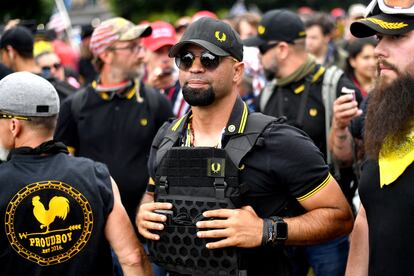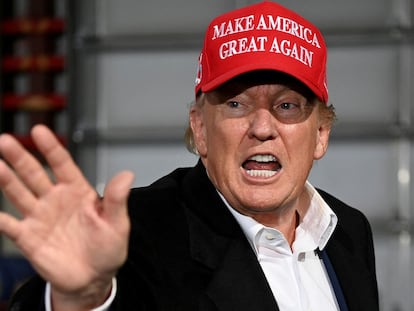Proud Boys leaders’ sedition trial over the January 6 attack inches to a close
A jury will soon decide whether the onetime leader of the Proud Boys extremist group is guilty in one of the most serious cases brought in the insurrection at the U.S. Capitol

After almost three months of testimony, dozens of witnesses and countless legal fights, a jury will soon decide whether the onetime leader of the Proud Boys extremist group is guilty in one of the most serious cases brought in the January 6, 2021, attack on the U.S. Capitol.
Closing arguments could be as early as this week before jurors decide whether to convict Proud Boys national chairman Enrique Tarrio and four lieutenants of seditious conspiracy for what prosecutors say was a plot to forcibly stop the transfer of presidential power from Republican Donald Trump to Democrat Joe Biden after the 2020 election.
In a trial that has lasted over twice as long as expected, little new information has emerged about the January 6 attack that halted Congress’ certification of Biden’s victory or the far-right extremist group’s role in the Capitol riot. But a guilty verdict against Tarrio, who wasn’t even in Washington, D.C., when the riot erupted, would affirm that those accused of planning and inciting the violence could be held responsible even if they didn’t join in it.
The case is nearing a close as a new problem may be on the horizon for the Proud Boys, a neofacist group known for brawling and street fights with left-wing activists and disrupting storytelling sessions by drag performers and other LGBTQ events around the country.
The group, Tarrio and two others on trial are also facing a separate, multimillion-dollar lawsuit. A judge is poised to decide how much they should have to pay a historic Black church in Washington for Proud Boys destroying a Black Lives Matter sign during a weekend of pro-Trump rallies in December 2020 that erupted into violence. Metropolitan African Methodist Episcopal Church is seeking up to $22 million in punitive damages, saying it was part of an effort to intimidate those who fight for racial justice.
Tarrio wasn’t in Washington on January 6 because he had been arrested two days earlier for his role in burning another Black Lives Matter banner torn down from a different Washington church, Asbury United Methodist. Tarrio was ordered to stay out of the city after his arrest.
The seditious conspiracy case in Washington’s federal court, which began with opening statements in January, has been slowed by bickering between the judge and defense attorneys, repeated requests for a mistrial, lengthy cross-examinations of witnesses and other legal maneuvers that often kept jurors waiting in the wings instead of hearing courtroom testimony.
On trial with Tarrio are Proud Boys chapter leaders Ethan Nordean, of Auburn, Washington; and Zachary Rehl, of Philadelphia; self-described Proud Boys organizer Joseph Biggs, of Ormond Beach, Florida; and Dominic Pezzola, a Proud Boys member from Rochester, New York.
It is unclear if any of them will testify before the defense rests and jurors hear attorneys’ closing arguments.
The backbone of the government’s case is a trove of messages that Proud Boys leaders privately exchanged on the Telegram platform before, during and after the Capitol riot. Their online rhetoric became increasingly angry with each failure by Trump’s lawyers to challenge election results in court.
“If Biden steals this election, (the Proud Boys) will be political prisoners,” Tarrio posted in Nov. 16, 2020. “We won’t go quietly ... I promise.”
As the mob attacked Capitol, Tarrio posted on social media, “Don’t (expletive) leave.”
When a Proud Boys member asked, “Are we a militia yet?” Tarrio responded with one word — “Yep” — in a voice note.
“Make no mistake,” Tarrio wrote. “We did this.”
Defense attorneys have argued that there is no evidence of a plan for the Proud Boys to attack the Capitol on January 6.
They have stressed that Proud Boys had FBI informants in their ranks who didn’t raise any red flags about the group before January 6. In an effort to show jurors that Tarrio was trying to avoid violence, they also showed how Tarrio frequently communicated with an officer assigned to monitor extremist groups’ activity in Washington and advised the officer of the group’s plans in the weeks before January 6.
Several Oath Keepers leaders and members who previously stood trial on seditious conspiracy charges similarly argued that the riot was a spontaneous outpouring of election-fueled rage, not the result of a premediated plan. While prosecutors said the Capitol attack was only a means to an end in the Oath Keepers’ larger plot to stop the transfer of power, defense attorneys repeatedly raised the lack of evidence that the Oath Keepers had an explicit plan to storm the Capitol.
In the end, prosecutors managed to secure seditious conspiracy convictions at trials against Oath Keepers founder Stewart Rhodes and five other members, but three others were acquitted of the charge. Those others, however, were convicted of other serious felonies. Sentencings for Rhodes and other Oath Keepers are scheduled for next month.
In the Oath Keepers case, prosecutors could point to a cache of guns stashed at a Virginia hotel as evidence they planned to use force to stop the transfer of power, a key element of the crime.
Among the Proud Boys defendants, only Pezzola is accused of engaging in violence or destruction after being filmed smashing in a Capitol window with a riot shield.
The prosecutors in the Proud Boys case have instead argued that Tarrio and the others handpicked and mobilized a loyal group of foot soldiers — or “tools” — to supply the force necessary to carry out their plot.
Defense attorneys say that’s an unusual, flawed legal concept, and their messages were taken out of context. They’ve also painted Tarrio in particular as a scapegoat for the riot and an easier person to blame than Trump, whose spoke to a crowd of supporters just before they marched on the Capitol. Pezzola’s lawyers even tried to subpoena Trump, but the effort seemed to go nowhere.
Even without his testimony, Trump could factor into the jury’s verdict. Jurors saw a video of the 2020 presidential debate at which Trump told the Proud Boys to “stand back and stand by,” a moment that led to an explosion of attention and membership requests.
“These men did not stand back. They did not stand by. Instead, they mobilized,” Assistant U.S. Attorney Jason McCullough told jurors.
Key prosecution witnesses included two former Proud Boys members who cooperated with the government in hopes of getting lighter sentences. One of them, Matthew Greene, testified that Proud Boys members were expecting a “civil war” after the 2020 election. The other, Jeremy Bertino, testified that the Proud Boys saw themselves as “the tip of the spear.”
Bertino is the only Proud Boy who has pleaded guilty to a seditious conspiracy charge. Both said they didn’t know of a specific plan to storm the Capitol, though Bertino said they wanted to keep Biden from taking office. Greene said group leaders celebrated the attack on January 6 but didn’t explicitly encourage members to use force.
The trial was briefly disrupted when prosecutors told defense attorneys that a woman expected to testify for Tarrio’s defense had secretly worked as an FBI informant after the January 6 attack. Defense attorneys were alarmed because the woman had been in touch with the defense team, but prosecutors said the informant was never told to gather information about the defendants or their lawyers. Tarrio’s lawyers ultimately decided not to call her as a witness.
In the civil case brought by the Metropolitan AME, the judge is expected on Tuesday to hear final arguments from the church. The case is against the Proud Boys as an entity as well as Tarrio, Biggs, Nordean, Bertino and another member. The judge has already said they will be liable by default because the group failed to respond to the lawsuit or participate in the case. The only question remains is how much, if anything, they will have to pay.
Sign up for our weekly newsletter to get more English-language news coverage from EL PAÍS USA Edition
Tu suscripción se está usando en otro dispositivo
¿Quieres añadir otro usuario a tu suscripción?
Si continúas leyendo en este dispositivo, no se podrá leer en el otro.
FlechaTu suscripción se está usando en otro dispositivo y solo puedes acceder a EL PAÍS desde un dispositivo a la vez.
Si quieres compartir tu cuenta, cambia tu suscripción a la modalidad Premium, así podrás añadir otro usuario. Cada uno accederá con su propia cuenta de email, lo que os permitirá personalizar vuestra experiencia en EL PAÍS.
¿Tienes una suscripción de empresa? Accede aquí para contratar más cuentas.
En el caso de no saber quién está usando tu cuenta, te recomendamos cambiar tu contraseña aquí.
Si decides continuar compartiendo tu cuenta, este mensaje se mostrará en tu dispositivo y en el de la otra persona que está usando tu cuenta de forma indefinida, afectando a tu experiencia de lectura. Puedes consultar aquí los términos y condiciones de la suscripción digital.
More information
Archived In
Últimas noticias
Most viewed
- Reinhard Genzel, Nobel laureate in physics: ‘One-minute videos will never give you the truth’
- Oona Chaplin: ‘I told James Cameron that I was living in a treehouse and starting a permaculture project with a friend’
- Pablo Escobar’s hippos: A serious environmental problem, 40 years on
- Chevy Chase, the beloved comedian who was a monster off camera: ‘Not everyone hated him, just the people who’ve worked with him’
- Why we lost the habit of sleeping in two segments and how that changed our sense of time










































